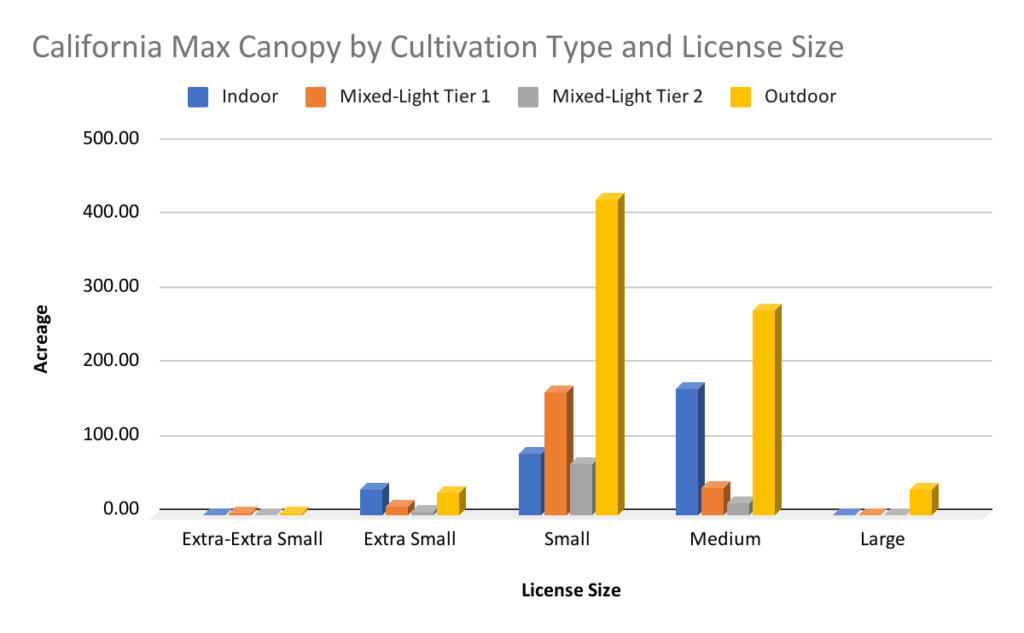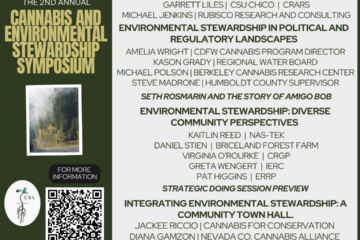All data displayed below were pulled from the California Department of Cannabis Control Cannabis Unified License Search tool, accessed on January 29, 2024.
Our second post (California License Types: License Counts, and Maximum Canopy) introduced readers to California’s aggregate data on license types and maximum canopy size.
A third way to compare counties is by energy source and intensity represented in license categories: Outdoor, Mixed-Light Tier 1, Mixed-Light Tier 2, and Indoor. Each license type, from Extra-Extra Small to Large, also varies by whether it is outdoor, indoor, or one of two hybrid light types.
Outdoor Licenses: Nothing but the Sun and Maybe Some Tarps
Until November 2023, Outdoor license types were only defined by whether plants were grown fully in the sun, without the use of any building structure. The rules were changed to allow Outdoor license holders to engage in “traditional light deprivation”: the use of hoop house structures and manually pulled tarps to induce flowering, as long as no energy is used while the plants are in those structures.
This is also why Medium Outdoor licenses were, and remain, allowed to have a full acre of maximum canopy, unlike other Medium licenses that get up to half an acre. Licensees that do traditional light deprivation were allowed to change their license type from Mixed-Light Tier 1 to Outdoor after the November 2023 ruling – doubling their maximum canopy.
Medium Outdoor licenses now include both “full term” (one crop per year) and “light dep” (at least two, sometimes three) crops per year. Generally, the yield per square foot on light dep styles is lower than for full term – and it is a LOT more manual labor to pull tarps. So even though light dep Medium Outdoor crops may be potentially larger than they were before last fall, the cost and degree of difficulty doing more than one crop a year at that scale is challenging.
Although full term outdoor plants can be much bigger than their light dep, hybrid and indoor counterparts, they are subject to environmental variations common to other forms of agriculture, including fires, and you only get one round each year.
Hybrid Mixed Light Tiers 1 and 2: Two Degrees of Energy Use
“Mixed Light” is a slightly confusing term for cultivation styles that use energy from different sources than the sun. It’s not just a matter of sun and lamps, because there are a lot of ways that energy can be used in a structure that is also using the sun’s energy. Think fans, for example, or dehumidifiers. And “Mixed light” growing styles may involve blocking out the sun as well as adding artificial light earlier in the year to get plants going.
Light deprivation and light supplementation are two ways that farmers can get more than one crop in a year. Plants in a structure that allows for light supplementation can get started earlier in the year, and if a structure is used to block out light to induce flowering, they can finish earlier as well. For both situations, energy may be used: to heat the air in cold weather, or cool the air in hot weather. And for both situations, fans may be used to facilitate air flow.
The more energy is used, the higher-tech the structure in which plants are flowered is.
Mixed Light Tier 1 licenses use a minimal amount of additional energy, under 6kw hours per square foot. They do not flower year-round. They combine manual labor with limited automated techniques.
Mixed Light Tier 2 licenses use more energy, 6-25 kw hours per square foot, and are comparable to indoor, since they can usually flower year-round. Mixed Light Tier 2 licenses are very high tech, and use automated techniques for everything – up to and including how they block out light.
Indoor
Indoor license types are fully enclosed systems using only artificial light to flower plants. They come in a range of sizes, from extra-extra small to, well, warehouse. As you can see in the following table, Indoor cultivation makes up a tiny fraction of the licensed cannabis produced in California. And yes, some counties are predominantly “Indoor.” We will explore this in later posts.
Full Sun, Hybrid, and Indoor: Aggregate Max Canopy and Total Licenses in California by License Size


Our next post takes a different approach for comparing cultivation counties in California: “unique ownership.” Some cultivations are characterized by high levels of ownership concentration, while others feature a more diverse ownership landscape.


0 Comments